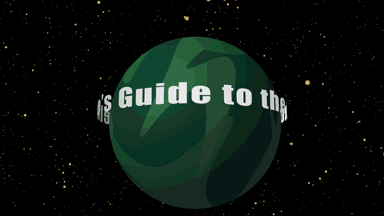Scienceline’s Guide to the Exoplanets: The Tugging Triplet
Pollux b: In search of counterparts
Rahul Rao • November 16, 2020

Your favorite planets, and you didn't even know they existed. [Credit: Curtis Segarra | CC BY-NC-ND 2.0]
Your favorite planets, and you didn't even know they existed. [Credit: Curtis Segarra | CC BY-NC-ND 2.0]
The Tugging Triplet
Pollux b
Discovered by: Artie P. Hatzes et al
Discovered: 2006
Distance from Earth: ~34 light-years
Mass: ~3 Jupiter masses
Surface climate: Probably quite warm
Habitability for humans: Sadly, no.
Pollux is an old star, at least as far as the cosmos is concerned. It’s an orange giant late in its lifespan; it has expanded away from the main sequence as it’s entered the sunset years of its life, and within a few billion years, that life will end completely.
Pollux is also an ancient star, at least as far as humans’ understanding of the skies is concerned. It’s the closest giant star to Earth and the brightest star in the constellation Gemini, and it’s been prominent in the sky for thousands of years. It has appeared in everything from Babylonian and Greek and Chinese astronomy to Percy Shelley poetry.
Pollux also has at least one planet: a gas giant, several times larger than Jupiter. If it were placed around the Sun, it would orbit between Earth and Mars. Pollux is still the brightest star — as we see it from Earth — known to have an exoplanet.
To talk about the discovery of Pollux b, our final exoplanet, we should go back into the misty depths of 1993. That year, the astronomers Artie P. Hatzes and William Cochran were trying to measure the radial velocities of several orange giants, including Pollux. What they found were discrepancies; the stars seemed to be wobbling, moving ever-so-slightly towards and away from Earth, in regular cycles.
They suggested the cause of that wobble could be a planet, several times the mass of Jupiter, pulling back at the star. In fact, measuring such pulls on stars is how a large portion of today’s known exoplanets are discovered.
In 1993 exoplanet science was deep in its infancy. The only confirmed planets orbited pulsars, and any suggestion of a planet around a star like Pollux — and a star so relatively close to Earth, at that — was highly speculative at best. Indeed, since Pollux’s pattern matched that of other stars they studied, Hatzes and Cochran concluded the discrepancy they found had more to do with some intrinsic property of giant stars.
But thirteen years later, Pollux b was discovered.
Even though we don’t know much else about Pollux b — it hasn’t been studied in great detail since — there’s still a reason it’s worth mentioning. Hatzes and Cochran’s initial study also focused upon two other, similar giant stars: Arcturus and Aldebaran.
In 2015 astronomers confirmed a gas giant around Aldebaran.
Arcturus, on the other hand, still has none…